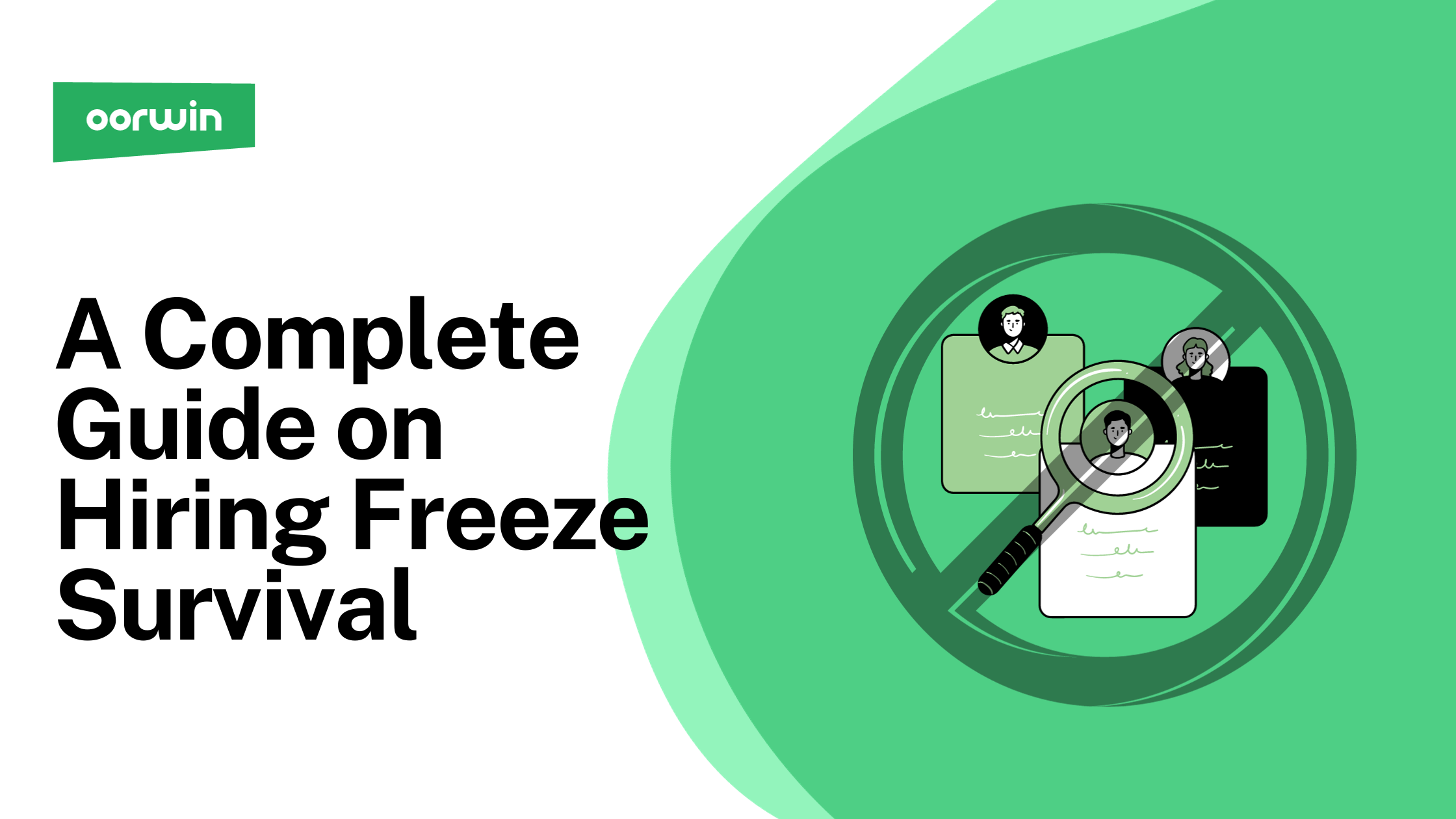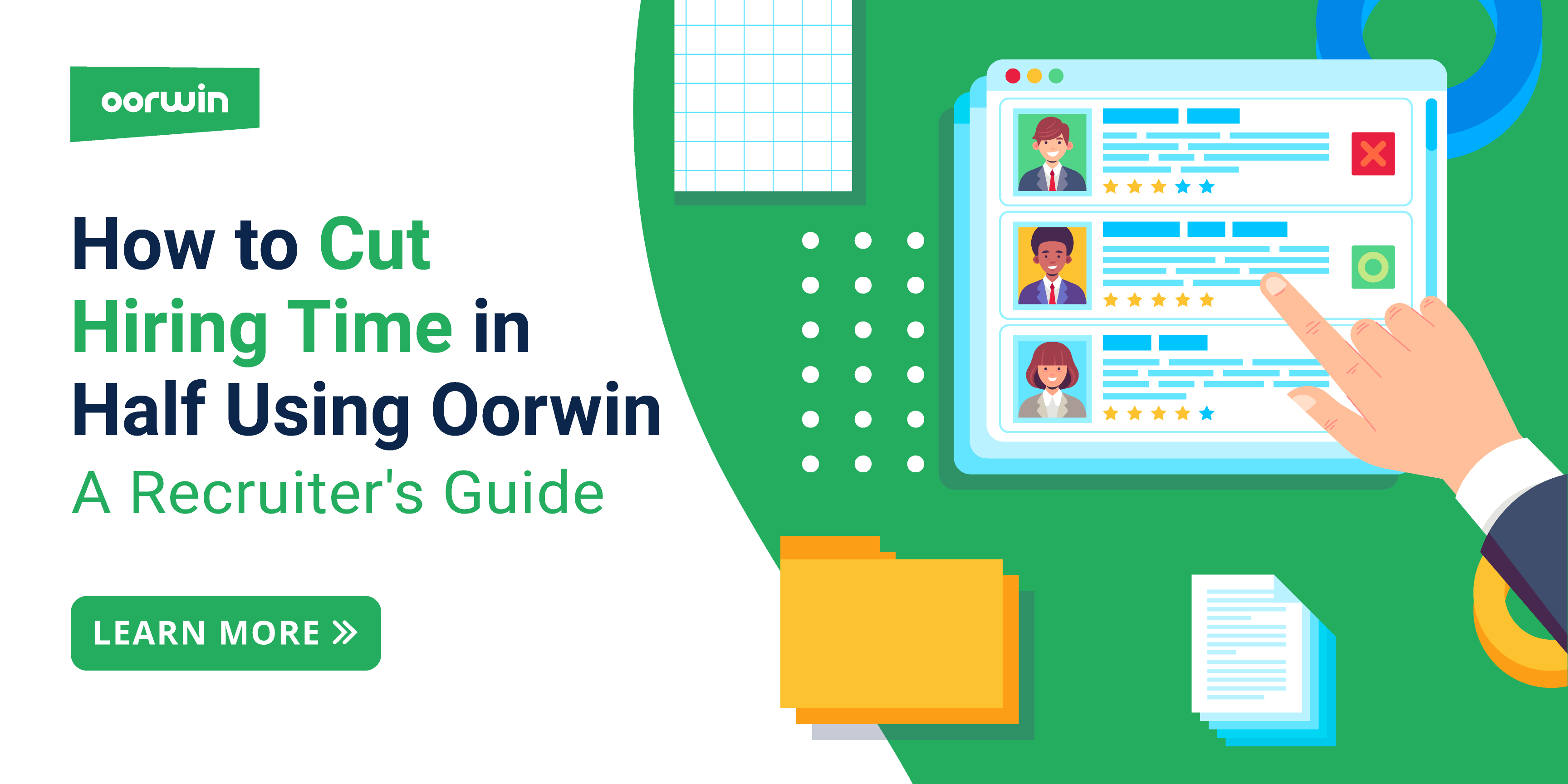Surviving a Hiring Freeze: Essential Guide & Tips
Oorwin
8min read / 31 Oct 2023

Related Articles
An In-Depth Guide to Overcoming the Challenges of a Hiring Freeze
Every business has its ebbs and flows, and sometimes, this includes a pause in recruitment, known as a hiring freeze. It’s crucial to understand that such a freeze is often a strategic decision, not necessarily a sign of distress. While the term ‘hiring freeze’ might sound daunting, it can actually serve as a valuable period for reflection, optimization, and strategic planning.
This guide is crafted to help you navigate these quieter times. We’ll delve into understanding the reasons behind a hiring freeze and crafting strategies to manage its impact. By doing so, you’ll be well-prepared and ready to spring into action when the hiring momentum picks up again. Let’s journey through this together, turning a period of pause into an opportunity for growth and strategic foresight.
What is a Hiring Freeze?
A hiring freeze is essentially a period when a company decides to temporarily halt the recruitment and onboarding of new employees. Think of it as a strategic pit stop in a race, where the organization takes a moment to reassess, refuel, and recalibrate its strategies and resources. This decision, while it may appear sudden, is often deeply rooted in strategic planning and reflects the company’s adaptability. It’s a proactive measure to ensure that resources are allocated wisely, helping the organization stay agile amidst changing circumstances.
Far from indicating stagnation, a hiring freeze can actually be a catalyst for growth and introspection. It provides an opportunity for teams to optimize existing resources, upskill current employees, and prepare for upcoming challenges. Therefore, when the freeze is lifted, the company doesn’t just resume hiring; it does so with renewed vigor, clearer focus, and a redefined purpose. Emerging from this period, the organization is stronger, more focused, and better equipped to embrace future opportunities.
Why Do Companies Implement Hiring Freezes?
The primary goal of any business is to maintain financial stability over the long term. When a company faces substantial cash flow issues due to adverse market situations or a marked decrease in revenue, its primary focus shifts to conserving financial resources to sustain ongoing operations. In such situations, company management often opts for a hiring freeze. Here are some typical situations that might prompt a company to consider implementing a hiring freeze:
1. Market Uncertainty
The business world is full of surprises. Economic roller coasters, emerging industry trends, or unexpected global events can shake things up. When the future looks foggy, companies might decide to wait before adding new members to their team. This pause allows them to gauge the situation better and make informed decisions, ensuring they’re aware of sudden market shifts.
2. Budget Constraints and Fiscal Responsibility
Financial prudence is key in managing an organization well. Sometimes, it’s really important to focus on how you’re spending your money, especially when you need to fund big projects or get through tough financial times. Being smart about spending is essential during these periods. A common way to do this is to stop hiring new people for a while. This move helps them save cash, especially when they’re worried about uncertain times ahead.
When there’s a good chance the economy might take a downturn, or if big changes are expected, companies might stop hiring to cut costs. Sometimes, they do this even if they’re not sure what’s going to happen, just to make sure they have enough money on hand and keep their finances solid.
Expense guidance is like a detailed plan for how much a company plans to spend on certain things. It’s used to track how much money is supposed to be spent and how much actually gets spent. This helps businesses keep an eye on their budgets and make sure they’re not overspending.
3. Mergers and Acquisitions:
When a company merges with or buys another one, it’s like mixing two different cultures together. This period is really important for looking inward and figuring things out. The new, combined company needs to look at its employees and see where things match up well and where there’s some overlap. During this time, it often makes sense to stop hiring new people. This helps everyone adjust smoothly and lets the new organization structure get settled in properly. It’s a critical step to ensure that resources are utilized efficiently and to prevent any unnecessary duplication of roles. Plus, it gives the team a chance to blend together and work effectively in this new environment.
4. Global Emergencies
Events like pandemics, geopolitical crises, or natural calamities can send shock waves through the business world. Companies need to pivot rapidly, reallocating resources to address immediate challenges. A hiring freeze during such times is a strategic move, ensuring the organization remains agile and resilient.
This approach allows businesses to focus their energy and resources on essential areas, rather than expanding their workforce. It also helps in maintaining a lean operational model, which is crucial when navigating through unpredictable and turbulent periods.
5. Technology Advancements:
The digital age is upon us, bringing a wave of technological innovations. As companies ride this wave, there’s a need to reassess workforce requirements. Some roles become redundant, while others evolve or emerge. A pause in hiring allows companies to realign their talent strategy with the tech landscape.
This break gives them time to train current employees for new tech-driven roles and identify gaps that need filling with future hires. It’s also a chance to streamline operations and integrate new technologies effectively, ensuring the company stays relevant and competitive in a fast-changing digital world.
6. Emerging Liquidity Concerns
Anticipating challenges is a sign of a forward-thinking company. If there are indications of potential financial headwinds, a proactive approach might involve freezing hiring. This ensures the company is well-prepared, with a focus on stability and long-term growth.
In times of reduced liquidity, pausing hiring helps redirect funds from salaries to essential current assets, safeguarding the company’s ability to meet short-term obligations. Additionally, hiring freezes enable the reorganization of work teams for greater productivity, without significantly impacting the delivery of key products and services. While the hiring pause is in place, critical roles and specialist positions can still be temporarily filled by consultants or part-time staff to maintain core operations.
7. Strategical Avoidance of Layoffs
Implementing a hiring freeze can also be a strategic move to avoid layoffs. This is especially relevant when companies face tough financial situations. By pausing new hires, they can keep costs under control and stay within their budget.
This strategy is particularly focused on keeping long-term employees on board. Instead of hiring new people, companies choose to prioritize their existing staff. This helps in saving costs that would otherwise be spent on recruiting and training new employees. It’s a way to ensure stability for current employees while managing financial constraints effectively.
8. Ensuring Regulatory Compliance
Sometimes, companies may pause hiring to focus on ensuring they’re following government labor laws. This could be for things like audits or checking that their practices are up to legal standards. A hiring freeze gives them the time to do this without the added task of bringing in new staff. It’s a way to ensure they’re on the right side of the law and keeping their work environment stable and compliant.
Effects of a Hiring Freeze
A hiring freeze is a significant decision for any organization, often reflecting its response to financial challenges or changing business needs. While primarily aimed at controlling costs, such a move also has various other implications for the company’s operations, team dynamics, and long-term strategies. Let’s delve into these effects further.
Increased Workload and Employee Burnout:
When recruitment stops, the existing team often has to pick up the slack. This can mean longer hours, tighter deadlines, and mounting pressure. Over time, this heightened workload can lead to burnout, affecting not just productivity but also the overall well-being of employees.
Challenges in Filling Critical Positions:
Every role in a company has its significance. However, some positions are pivotal to the smooth running of operations. A hiring freeze can mean these critical roles remain unfilled, leading to potential bottlenecks, inefficiencies, and missed opportunities.
Reduced Morale and Job Satisfaction:
Uncertainty can be a morale killer. When employees see a halt in hiring, questions arise. “Is the company doing okay?” “Is my job secure?” Such concerns can lead to decreased job satisfaction, affecting performance and company culture.
Potential Repercussions on Reputation:
The job market is a two-way street. Just as companies assess candidates, potential hires evaluate companies. A prolonged hiring freeze can raise eyebrows, making top talent think twice before considering the company in the future. Managing external communications effectively is essential to ensure the company’s brand remains strong.
Serves as an Opportunity
A hiring freeze isn’t just a challenge; it can be a chance for existing employees to shine. With no new hires coming in, current team members often have more responsibilities. This situation gives them the opportunity to demonstrate their skills and knowledge. They can show how valuable they are to the company, taking on new roles and challenges that can lead to personal growth and professional development.
Key Actions to Take During a Hiring Freeze
Implementing a hiring freeze is a complex process. It’s crucial for an organization to monitor specific metrics during this period to maintain a balanced work environment and handle the challenges effectively. Here are some key areas to focus on:
- Boosting Employee Morale & Productivity: Keeping employee morale high is essential. You can do this by:
- Recognizing their work.
- Rewarding efforts.
- Offering upskilling opportunities.
- Seeking their feedback.
- Encouraging involvement in community projects.
- Promoting social activities.
Ignoring employee sentiments during a freeze can harm your business, as your workforce is central to your operations. Keeping them engaged and valued is key to retention.
- Budget: A hiring freeze often aims to reduce costs, especially during economic downturns. Monitoring your budget as per your expense guidance is critical during this phase.
- Expense Guidance: Staying within your budget limits is crucial. The duration of a hiring freeze can vary, so it’s important to keep a close eye on expenses to emerge from the crisis that prompted the freeze.
- Overall Execution: Pay attention to how your business operates during the freeze. This includes:
- Sticking to strategic plans.
- Maintaining compliance with regulations.
- Following policies and procedures.
- Ensuring employee well-being.
Strategies for Managing a Hiring Freeze
While a hiring freeze might seem like a roadblock, it can also be an opportunity for introspection and growth. By adopting smart strategies, businesses can maneuver through this period effectively. Let’s explore some of these tactics:
Assessing Current Staffing Needs
Before anything else, it’s essential to take stock. Which positions are vital for the company’s operations? Which roles can be deferred until the freeze is over? By identifying and prioritizing these roles, companies can ensure that essential functions continue to run smoothly.
Optimizing Existing Workforce
A hiring freeze can be an opportunity in disguise. It’s the perfect time to invest in the current team. Employees can be up skilled to take on additional responsibilities through training programs and workshops. This addresses immediate needs and contributes to employee growth and satisfaction.
Temporary Solutions and Outsourcing
Sometimes, the solution lies outside the organization. For critical roles that don’t warrant a permanent position during a freeze, temporary hires can be the answer. Alternatively, outsourcing certain functions can provide the expertise needed without long-term commitments. This flexibility allows companies to adapt to changing circumstances while keeping operations on track.
Boosting Your Company’s Image When Not Hiring
Even when you’re not actively hiring, there’s a great chance to enhance how people view your company as a workplace. It’s all about putting your current team front and center. Show how much you value their well-being and growth. This approach not only keeps your current employees content but also paints your company in a positive light for future talent. When the time comes to hire again, this reputation can really give you an edge in attracting the best candidates.
Using Tech to Streamline Hiring
Incorporating technology into your hiring process can make things a lot smoother and faster. Think about automating parts of the process, like sorting through resumes or setting up interviews. This not only saves time but also helps you focus on the most promising candidates. Also, using virtual tools for interviews and onboarding can be a game-changer, especially when meeting in person isn’t feasible. It’s all about making the process as efficient and hassle-free as possible for both your team and the applicants.
Navigate Hiring Freezes Effectively with Oorwin
During a hiring freeze, it’s crucial for companies to optimize their existing resources and prepare for future recruitment needs. Oorwin’s AI-Powered Talent Management Platform is designed to help businesses do just that. Here’s how Oorwin can help you:
- Streamline Talent Acquisition: Keep your candidate pool rich and ready for action with Oorwin’s intelligent sourcing and hiring tools.
- Enhance Talent Management: Focus on developing your current team’s skills with Oorwin’s comprehensive talent management solutions.
- Boost Recruitment Productivity: Utilize AI-Enabled Recruitment and Applicant Tracking System to refine your recruitment strategies, staying ahead of the curve.
- Integrate Seamlessly: Connect your favorite apps with Oorwin for a unified talent management experience.
- Leverage Analytics for Strategy: Make informed decisions using Oorwin’s advanced reporting and analytics during the hiring pause.
- Manage Talent Pipelines: With AI-Powered Talent CRM, keep your recruitment pipeline engaged and ready to activate.
Ready to optimize your talent strategy during and beyond hiring freezes?
Explore Oorwin Today and transform your talent management approach!
FAQ
What is a hiring freeze?
A strategic pause in recruiting new employees, often due to financial constraints or other organizational challenges.
What happens during a hiring freeze?
Recruitment stops, and companies might focus on optimizing their current workforce, leading to increased workloads for existing employees.
How do you respond to a hiring freeze?
Stay informed, communicate effectively with employees, and focus on strategic planning for when the freeze ends.
Popular Articles..
Blog

3min read / 25-Jun-2025
Master Effective Interview Techniques with Oorwin: A Step-by-Step Recruiter’s Guide
Blog
Blog
Get the latest Oorwin releases, updates, success stories & industry news
 Back
Back
